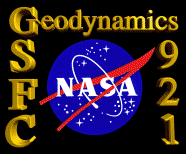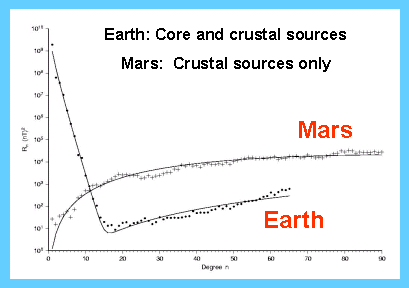

![]()
A recent paper now “In Press” in the Journal of Geophysical Research - Planets shows that a statistical theory developed to explain the Earth’s magnetic field also works well for Mars. As shown in the figure at the left, the magnetic spectrum for Mars is stronger than the Earth’s at high degree (long wavelength, n>13), and lacks the very distinct two-branch character of the Earth’s spectrum. The two branches in the curve for the Earth are taken to represent the main (core) field (n = 1-12) and crustal source fields (>13). The spectrum for Mars confirms the idea that the main core field for Mars has decayed away and today is virtually zero, but also shows the crustal field for Mars is far stronger than the Earth’s. This is likely due to a much thicker layer of very highly magnetized rocks than on the Earth. The source of this intense magnetization for Mars remains enigmatic.

|
Mean square magnetic induction on a sphere versus harmonic degree. Data points represent satellite observations. Curves show fits to the data for specific source models. For Earth (dots) the spectrum is the sum of a core field and a crustal shell of random dipoles. For Mars (crosses) the sources are random dipoles in a crustal shell only. The magnetic crust of Mars is thicker and far stronger than the Earth's. |
Contact: Coerte Voorhies, GSFC, Code 921 (voorhies@geomag.gsfc.nasa.gov)
![]()
![]() Back to Geodynamics Science Highlights
Back to Geodynamics Science Highlights
Responsible NASA official: Dr. Herbert Frey